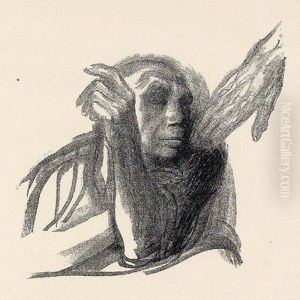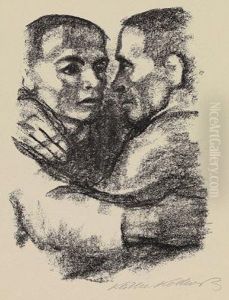Kathe Ko L Lwitz Paintings
Käthe Kollwitz was a German artist and sculptor, known for her powerful, emotional prints, woodcuts, and lithographs that often dealt with themes of poverty, hunger, and war. Born on July 8, 1867, in Königsberg, East Prussia (now Kaliningrad, Russia), she grew up in a socially conscious environment, with her father being a radical socialist and her grandfather a Lutheran minister who had been expelled from the church for his radical views. This environment undoubtedly influenced her later work, which was heavily centered on social advocacy.
Kollwitz received her initial art education in Königsberg. She then moved to Berlin to study painting, but soon discovered her true passion was for printmaking, which she felt was a more expressive and accessible medium. In 1891, she married Karl Kollwitz, a doctor who worked with the poor in Berlin, and his practice further exposed her to the plight of the working class. Her compassion for her husband’s patients and her own social convictions found expression in her art.
Her first major body of work, 'The Weavers' series (1893–1897), was inspired by Gerhart Hauptmann's play about a Silesian weavers' uprising and reflects her response to the hardships of the working classes. This was followed by another significant series, 'The Peasant War' (1902–1908), which depicted the brutal suppression of the German Peasants' War in the 16th century, drawing parallels to contemporary social issues.
Kollwitz's work was not limited to prints; she also created a significant number of sculptures, the most famous being 'The Grieving Parents', a memorial for her youngest son Peter, who died in World War I. This deeply personal loss profoundly affected Kollwitz, and her art in the subsequent years frequently dealt with themes of loss and mourning.
Throughout her life, Kollwitz's art was celebrated for its raw, emotional intensity and its unflinching focus on social issues. However, her work was not always well-received by authorities; her pacifism and opposition to the Nazi regime led to her being barred from exhibiting her work, and she was expelled from the Prussian Academy of Arts.
Kollwitz's commitment to depicting the struggles of humanity remained undimmed throughout her life. She continued to produce art until her death just weeks before the end of World War II, on April 22, 1945, in Moritzburg, Germany. Today, Kollwitz is remembered as one of the most important German artists of the 20th century, and her work remains highly regarded for its emotional power and its advocacy for social justice.

